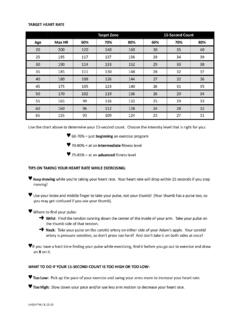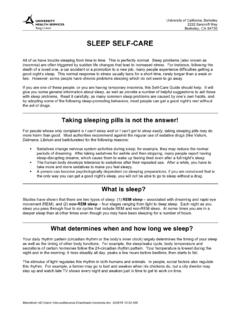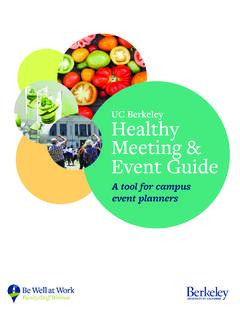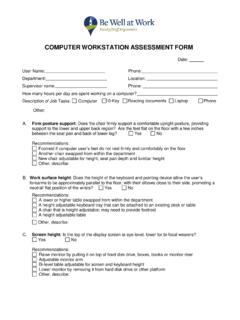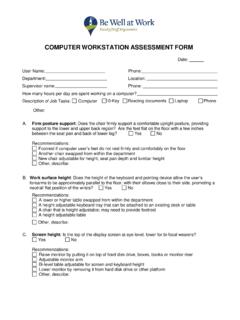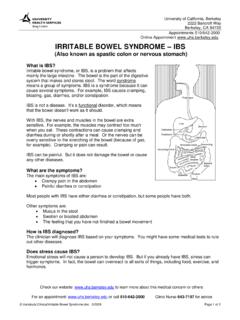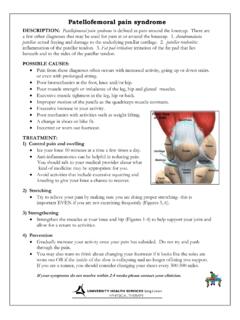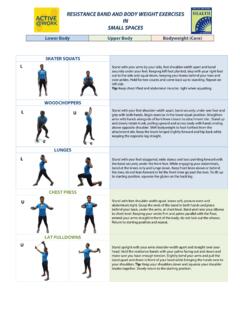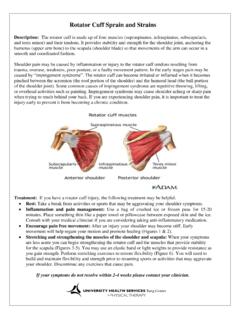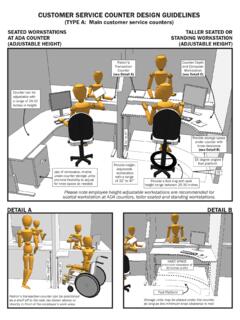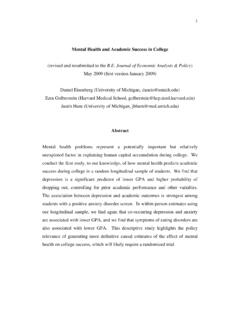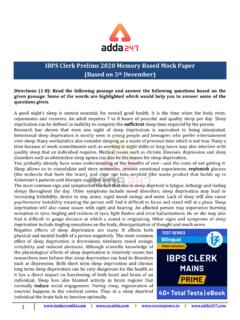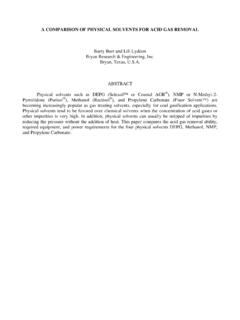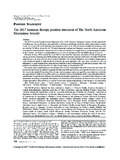Transcription of Guide to Understanding and Managing Anxiety
1 University of California, Berkeley 2222 Bancroft Way Berkeley, CA 94720 Guide to Understanding and Managing Anxiety Most people are familiar with feelings of Anxiety . Anxiety is a normal part of life. Anxiety is our body s way of responding to a physical, emotional, or intellectual challenge. What student has not felt a bit anxious before a final exam or oral presentation? In fact, moderate Anxiety during these situations can be mobilizing, resulting in better performance. However, if your test Anxiety is at the point where you are too anxious to go to the exam, or your mind consistently goes blank during the exam and you cannot recover, you are probably not experiencing ordinary, everyday Anxiety . Anxiety is a medical problem when it is persistent, overwhelming, and interferes with your day-to-day functioning.
2 Symptoms of Anxiety commonly include unrealistic fears and worries, physical complaints, such as upset stomach or rapid heart rate, and the avoidance of Anxiety producing situations. Over 19 million American adults struggle with Anxiety . While the exact cause of Anxiety disorders is uncertain, the problems probably result from a combination of factors including genetics, brain chemistry, personality, and life events. Anxiety can be successfully treated. The goal is not to eliminate Anxiety , but to reduce it to a manageable level. With the right treatment, many people begin to feel better immediately or in just a few weeks. What are the different types of Anxiety ? Generalized Anxiety Disorder (GAD) I can t stop worrying, I feel keyed up and unable to relax.
3 At times it comes and goes, and at times it seems constant. I worry about everything from making enough to send home to my family to what to give my best friend for her birthday. Now that I m about to graduate, there s even more things to worry about. I have trouble sleeping or concentrating when studying. Sometimes I feel a little lightheaded. My heart races or pounds. And that makes me worry more. I m always imagining things are worse than they really are: when I get a stomach ache, I think it s an ulcer. I can t turn off the worry- I m miserable. Generalized Anxiety disorder (GAD) is much more than the normal Anxiety people experience day to day. It s chronic and fills a person s day with exaggerated worry and tension, even though there is little or nothing to provoke it.
4 Having this disorder can mean always anticipating disaster, often worrying excessively about health, money, family, school, or work. Sometimes, though, the source of the worry is hard to pinpoint. Worries are usually accompanied by physical symptoms, such as fatigue, headaches, muscle tension and aches, difficulty swallowing, trembling, twitching, irritability, sweating, and hot flashes . People with GAD may feel lightheaded, out of breath, nauseated, and easily startled. Concentration and sleep problems are also common. Social Phobia In any social situation, I felt fear. I would be anxious before I even left the house, and it would escalate as I got closer to class, a party, or whatever. My heart would pound, my palms would be sweaty, and I would get this feeling of being removed from myself and from everybody else.
5 It happened again last year. I had to give a report in front of my class and I got so nervous and tongue-tied. I think I stammered something, sat down, and stared at my right shoe the rest of the class. I was so humiliated. My friends tell me they feel nervous before presentations too, but at least they can talk. I just go blank and stare. Social phobia is characterized by an intense fear of situations, usually social or performance situations, where the risk of embarrassment is present. It can disrupt normal life, interfering with school, work, or social relationships. It s not uncommon for people with social phobia to worry for days or weeks in advance of a social or performance situation. Physical symptoms often accompany the anxious feelings and include blushing, profuse sweating, trembling, nausea, shortness of breath, racing heart, and difficulty talking.
6 S:\handouts\Clinical\ Anxiety 04/17/20 Specific Phobias I m scared to death of flying, and I never do it anymore. It was an awful feeling when that airplane door closed and I felt trapped. My heart would pound and I would sweat bullets. These days I only go places where I can drive or take a train. My friends always point out that I couldn t get off a train traveling at high speeds either, so why don t trains bother me? I just tell them it isn t a rational fear. A specific phobia is an intense fear of something that poses little or no actual danger. Some of the more common specific phobias are centered on closed-in places, heights, escalators, tunnels, highway driving, water, flying, dogs, and injuries involving blood.
7 Facing, or even thinking about facing, the feared object or situation can bring on a panic attack or considerable Anxiety , even when the person recognizes how irrational the fear is. Panic Disorder It started 2 years ago, when I was sitting in a seminar and this thing came out of the blue. I felt like I was dying. In between attacks there is this dread and Anxiety that it s going to happen again. I m afraid to go back to places where I ve had an attack. People with panic disorder experience sudden episodes of intense fear that occur without any warning or apparent reason. They can t predict when an attack will occur, and many develop intense Anxiety between episodes, worrying when and where the next one will occur. A panic attack is marked by a group of symptoms that can include dizziness, racing heart, perspiring, shortness of breath, tingling hands, fears of dying or going crazy.
8 Attacks usually last no more than about 10 minutes. Post-Traumatic Stress Disorder I was assaulted when I was 22 years old. For a long time, I spoke about the attack as though it was something that happened to someone else. Then I started having flashbacks. They kind of came over me like a splash of water. I would be terrified. Suddenly I was reliving it. Every instant was startling. I wasn t aware of anything around me; I was in a bubble, just kind of floating. Having a flashback can wring you out. Post-traumatic stress disorder (PTSD) can develop following a terrifying event that a person experienced or witnessed. Whatever the source of the problem, some people with PTSD repeatedly relive the trauma in the form of nightmares and disturbing memories during the day.
9 Other symptoms may include sleep problems, feelings of detachment or numbness, hyper vigilance, irritability and aggressiveness. Some people avoid certain places or situations that are reminders of the trauma and anniversaries of the event are often especially difficult. Ordinary events can trigger flashbacks or intrusive images. A person having a flashback, which can come in the form of images, sounds, smells, or feelings, may lose touch with reality and believe that the traumatic event is happening all over again. Obsessive-Compulsive Disorder (OCD) I couldn t do anything without rituals. Counting really bogged me down. I would wash my hair three times as opposed to once because three was a good luck number and one wasn t. it took me longer to read because I d count the lines in a paragraph.
10 I knew the rituals didn t make sense, but I couldn t seem to overcome them until I had therapy. Obsessive-compulsive disorder, or OCD, involves having distressing thoughts or rituals that are time consuming and excessive. Distressing thoughts or images, such as worries about germs or dirt are called obsessions, and the rituals that are performed to try to prevent or get rid of these anxious thoughts, such as washing the hands over and over are called compulsions. The more common compulsions involve washing and cleaning, counting, repeating or checking actions. A lot of healthy people can identify with some of these symptoms of OCD, such as checking to see if the stove is turned off before leaving the house. But for people with OCD, such activities consume at least an hour a day, are very upsetting, and interfere with daily life.
